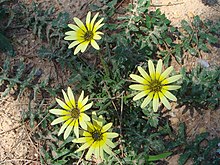Arctotheca calendula
| Arctotheca calendula | |
|---|---|

| |
| Scientific classification | |
| Kingdom: | |
| (unranked): | |
| (unranked): | |
| (unranked): | |
| Order: | |
| Family: | |
| Genus: | |
| Species: | A. calendula
|
| Binomial name | |
| Arctotheca calendula | |
| Synonyms[1] | |
|
Synonymy
| |
Arctotheca calendula is a plant in the sunflower family commonly known as capeweed,[2] plain treasureflower,[3] cape dandelion, or cape marigold because it originates from the Cape Province in South Africa.[4][5] It is also found in neighboring KwaZulu-Natal.[6]
Arctotheca calendula is naturalized in California, Spain, Portugal, Italy, Australia, and New Zealand, and considered a noxious weed in some of those places.[7][8][9][10][11][12][13][14]
Arctotheca calendula is a squat perennial or annual which grows in rosettes and sends out stolons and can spread across the ground quickly. The leaves are covered with white woolly hairs, especially on their undersides. The leaves are lobed or deeply toothed. Hairy stems bear daisy-like flowers with small yellow petals that sometimes have a green or purple tint surrounded by white or yellow ray petals extending further out from the flower centers. It is cultivated as an attractive ornamental groundcover but has invasive potential when introduced to a new area. The plant can reproduce vegetatively or via seed. Seed-bearing plants are most likely to become weedy, taking hold most easily in bare or sparsely vegetated soil or disturbed areas.[15]
References
- ^ The Plant List Arctotheca calendula (L.) Levyns
- ^ USDA, NRCS (n.d.). "Arctotheca calendula". The PLANTS Database (plants.usda.gov). Greensboro, North Carolina: National Plant Data Team. Retrieved 8 January 2016.
- ^ "BSBI List 2007". Botanical Society of Britain and Ireland. Archived from the original (xls) on 2015-01-25. Retrieved 2014-10-17.
{{cite web}}: Unknown parameter|deadurl=ignored (|url-status=suggested) (help) - ^ Levyns, Margaret Rutherford Bryan 1942. Journal of South African Botany 8(4): 284
- ^ Tropicos, Arctotheca calendula (L.) Levyns
- ^ Plantzafrica, Arctotheca calendula (L.) Levyns, Common Name: Cape dandelion, Cape weed
- ^ California Invasive Plant Council, University of California @ Davis
- ^ Calflora taxon report, University of California @ Berkeley, Arctotheca calendula (L.) Levyns, Cape weed
- ^ Atlas of Living Australia, Arctotheca calendula (L.) Levyns, African Marigold
- ^ Weeds Australia, Capeweed Arctotheca calendula [dead link]
- ^ Flora of New Zealand Arctotheca calendula (L.) Levyns
- ^ Flora Vascular de Andalucía Occidental, Arctotheca calendula (L.) Levyns in Spanish
- ^ Flora Catalana, Arctotheca calendula in Catalan with color photos
- ^ Altervista Flora Italiana, Arctoteca simile alla calendola, Arctotheca calendula (L.) Levyns numerous photos
- ^ Flora of North America Vol. 19, 20 and 21 Page 197 Arctotheca calendula (Linnaeus) Levyns
